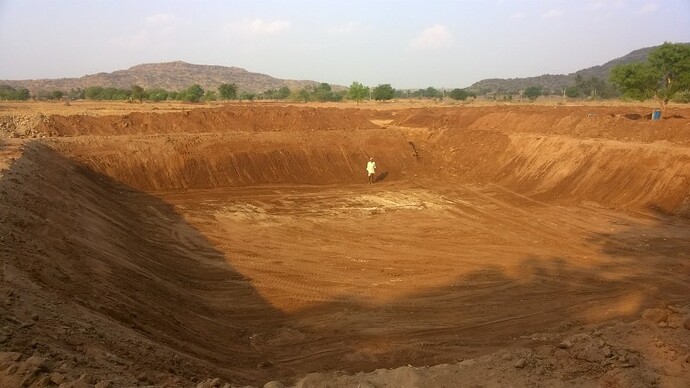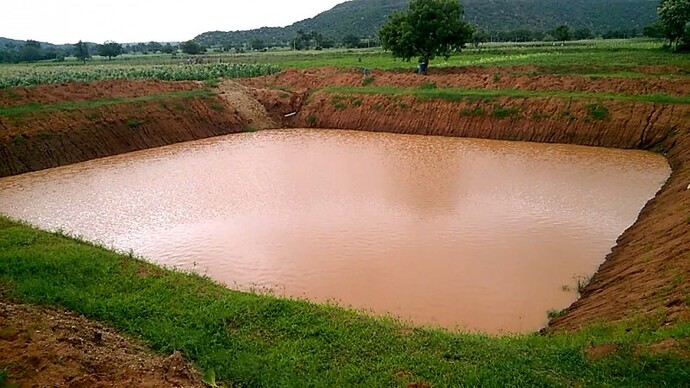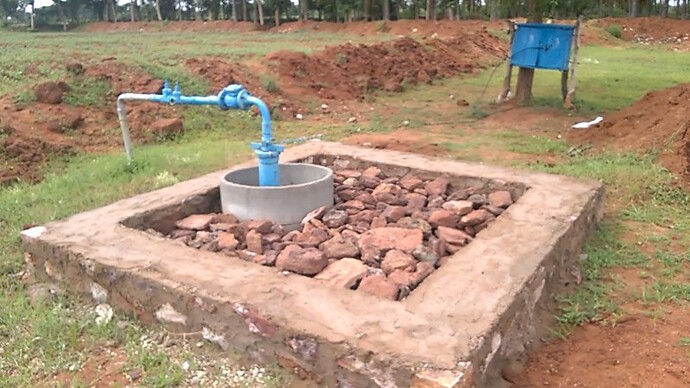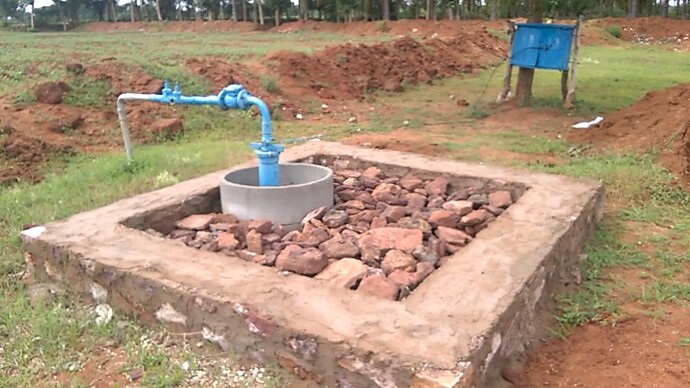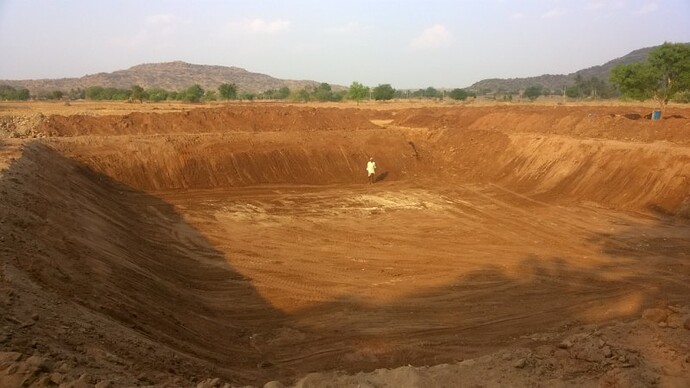Thank you Chandra for the patent documents. Just for info - since the previous discussion KFP has won a place in Mahindra Rise competition and their site has also been updated recently.
What are the porous material to be used per the above design …? Or in general .
Which is cost effective
environment friendly and
which remains to be porous over years…
I guess you can use gravel. Some sites suggest covering the pit with twigs and other organic matter as well. In the second case, the pit will close over a period of time.
But what is the benefit of porous material? By not having it, more water can be stored for percolation; what am I missing?
The suggested material is murum soil. But I think I read Kedia saying somewhere that river sand may be used as substitute. Have not come across gravel.
Palekar suggests digging trenches in coconut farms and filling them with organic matter to ensure humid environment and prevent evaporation. However this method should not be confused with Kedia Farm Pattern. KFP is a very specific, patented technique of harvesting rainwater.
I think the material is required mainly to press the PVC sheet lining against the base of the trench and against the outside wall of the trench. One might ask why is there a PVC sheet at all? There are two reasons, I think. One is prevent water from percolating in vertical direction directly to water table. The idea is instead to force it horizontally so that it is available to roots of trees and plants. Only once the soil’s water holding limit is crossed the surplus water then percolates downwards to the water table. Second is to prevent it from percolating to the side of the trench.
Chandra, just quoted what I had read. Sorry, no practical knowledge in this matter. ![]() You have more experience digging swales.
You have more experience digging swales.
One benefit of filling the pit with porous material I can think of is filtration. If the pit is open, water tends to carry top soil and deposit it in the pit, filling up the pit very quickly, especially on slopes.
Second benefit I can think of is the elimination of the risk of somebody falling into the pit (people, animals can badly injure themselves even if the pit is hardly 2 feet deep).
Cheers,
AK
Filling the swales is not new - I have certainly seen it referenced in permaculture literature. Thanks guys, the reasons for filling the swales seem logical, though I still have a preference for open swales.
Newbie - from my limited understanding, the only differentiating thing with KFP seems to be the wrapping - I mean PVC - I am not sure how that helps in practice though - forcing horizontally etc.
All - a general note on discussing KFP: I think technically there is no holdup on discussing the technique or the publicly published patent details; however it is just an addition/modification to the large number of methods in the literature and we seem to be giving just one commercial version too much importance. ![]()
I think Mr. Vijay Kedia is on the forum too and might respond; he is aware the supposed copyrighted image has been removed on request and we just have public domain materials on the forum now. Probably at some point, we could hive off all discussion on his technique to a separate thread.
Thanks.
Porous material as Ak suggested might help percolate water quickly and filtered …
I think … instead of just generic porus material … I would say … multiple layers of materials might add more benefit like sand … coal …crushed stone and coco pit kind of filler materials ![]()
As Chandra mentioned , dig a swale little deeper and fill this materials and keep a farmnest sign cut in woof towards northwest corner of the swale that could also improve the water levels:) ( farmnest sign is meant to be sarcastic )
On the other hand , how ever good or bad is his method patent , Anupam Mishra and Rajiv Dixit kind of NGO have gathered and propagated this harvesting methods. I am not questioning his time and efforts but trying to charge in the name of patent is like some companies patenting our Turmeric and Rice …
This is what I am mulling on.
Let us say we have a swale with holding capacity of 10,000 liters. Unfilled with any material, this can hold 10,000 liters and any additional incoming water runs off. Then the water percolates in all three directions through the whole surface area of the swale, and blocking the bottom seems to be recommended in some techniques anyway.
When filled, the holding capacity would be just the inter-particle spaces, which probably would be 2,000 liters, and everything more is runoff. The percolation would be just the same since the percolating surface area of the swale is still the same. One difference is that the percolation is spread over the higher sections of the swale even when there is a limited inflow, as against the bottom surface getting all the water in an open swale.
Filtration - I visualize the scope of blockage higher in a filled swale. In an open one, the soil runoff just falls to the bottom but does not block all the swale; can be removed if it gets unacceptably high in the swale.
The other benefit of an open swale is that it can be used as a path when not having water (which is 95% of the time) if it is wide enough.
Deep borewells nearby rain harvest ponds make them dry in a short period.
If there is no borewell around 1000 meters from the pond, then it may ratain little longer.
Wow, It took me 2 hours to read this topic. A real good discussion.
My requirement is to take water from top of godown, filter using some kind of filter then recharge borewell.
I had talk with local mechanic & he right away refused with 2 reasons.
1 - rain water coming from top of any surface will have small sand particles even after getting filtered in filter, If this is entered with direct injection from top of borewell, it will block or spoil borewell motor.
2 - borewell will have 1 way or 2 way valve at the end of it. If its 2 way then only it will allow to flow water from top.
I am fully confused & local mechanic is in no mood to implement rain water system. Is there anyone who can help with diagram, documents, or on phone or personal visit ?
Location - Rajkot area, Gujarat.
Thank you.
This is called direct injection recharge method of RWH. You will find some basic info at the link below and a list of people you may contact for more
And these:
https://discuss.farmnest.com/t/design-for-artificial-ground-water-recharge-needed/446
https://discuss.farmnest.com/t/ground-water-recharge-solve-water-problems/343
We could create a raw water reservoir using HDPE lining directly on compacted soil surface ( no other treatment required). The HDPE lining ewould be installed with on site testing for zero leaks. This reservoir would be at the lowest point in your farm to ensure rain water run offs are collected there.
Ajit Mathew,
Planck Infratech Pvt Ltd.,
1st Floor, 3-45-42,
8, Picket Road,
Secunderabad: 500026.
Phone : +91-9866077560.
Hi planck,
Can you provide any indicative costs?
Chandra
Mr. Chandra,
Cost would be around Rs 230 per sqm…all installed and welded at site.
Planck Infratech Pvt.ltd.
Sameer
How many hours did it take for you to dig the 100x100x10 pit
What is the second layer of pipe around the casing pipe.
Surprised to see the casing pipe not bending or breaking due to the load of the borewell and pipes, did you have HDPE pipes
I have got this done in my farm of 17 acres. The region receives avg annual rainfall not greater than 600mm. Something similar needs to be done specific to your region.
Hi Sameer, what has been the experience with the storage?
Do you believe this is sufficient to raise an orchard round the year or does it serve only a supplemental irrigation or two in peak summer?
